Principles of Marketing: Sainsbury's Environmental Analysis - UWL
VerifiedAdded on 2023/06/14
|10
|2358
|347
Report
AI Summary
This report provides an environmental analysis of Sainsbury's, a leading UK supermarket chain, using various marketing principles and frameworks. It begins with an introduction to Sainsbury's, its mission, and its market position. The report then delves into internal factors like product issues, marketing challenges, and management concerns, highlighting the company's strengths and weaknesses. A PESTLE analysis examines external factors, including political, economic, social, technological, legal, and environmental influences, impacting Sainsbury's competitive advantage. A SWOT analysis summarizes the internal strengths and weaknesses, as well as external opportunities and threats. Recommendations are provided for Sainsbury's to address challenges related to Brexit, transportation, health-conscious consumers, and technological advancements. The report concludes that understanding marketing principles and conducting environmental analyses are crucial for businesses to scale operations and adapt to market dynamics. Desklib provides access to similar solved assignments and study resources for students.
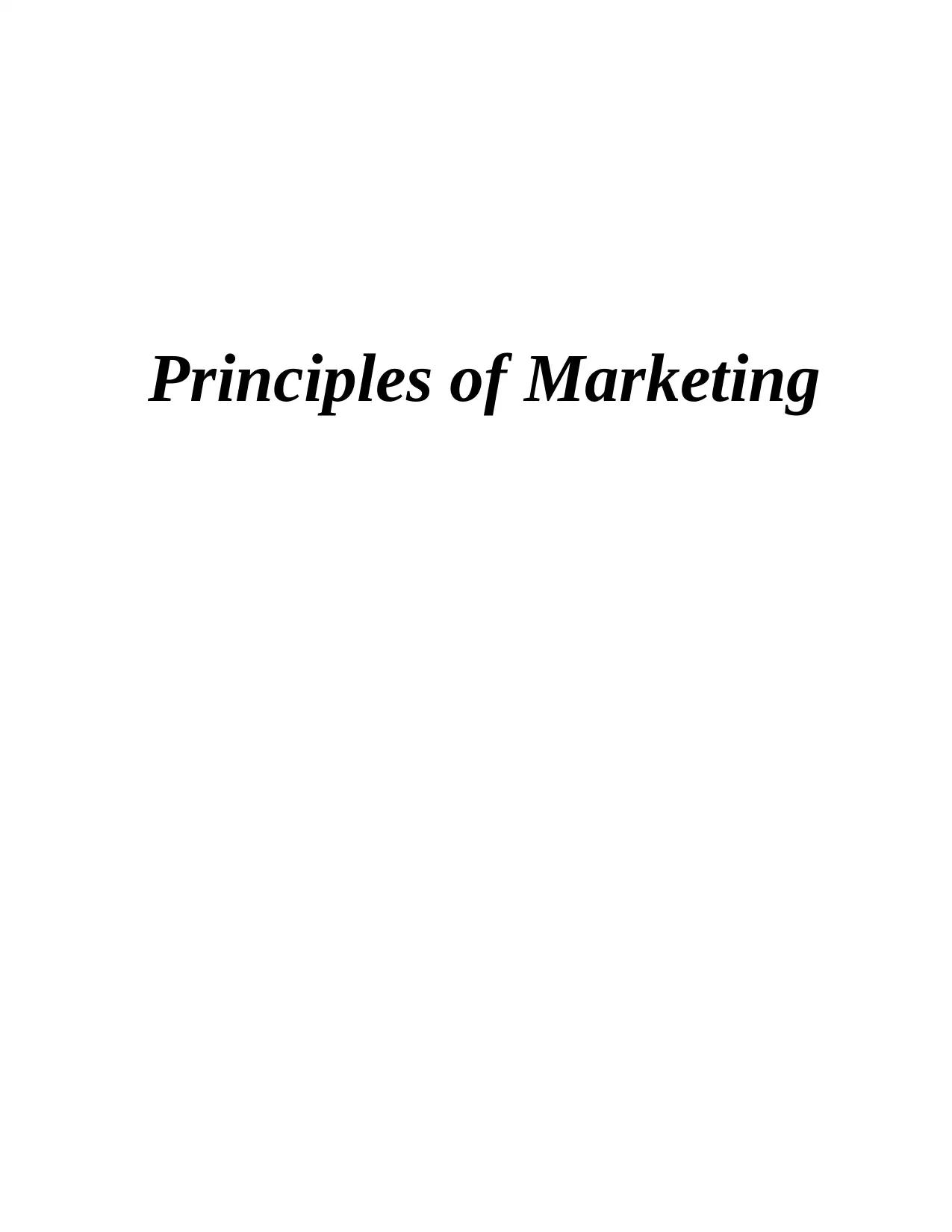
Principles of Marketing
Paraphrase This Document
Need a fresh take? Get an instant paraphrase of this document with our AI Paraphraser
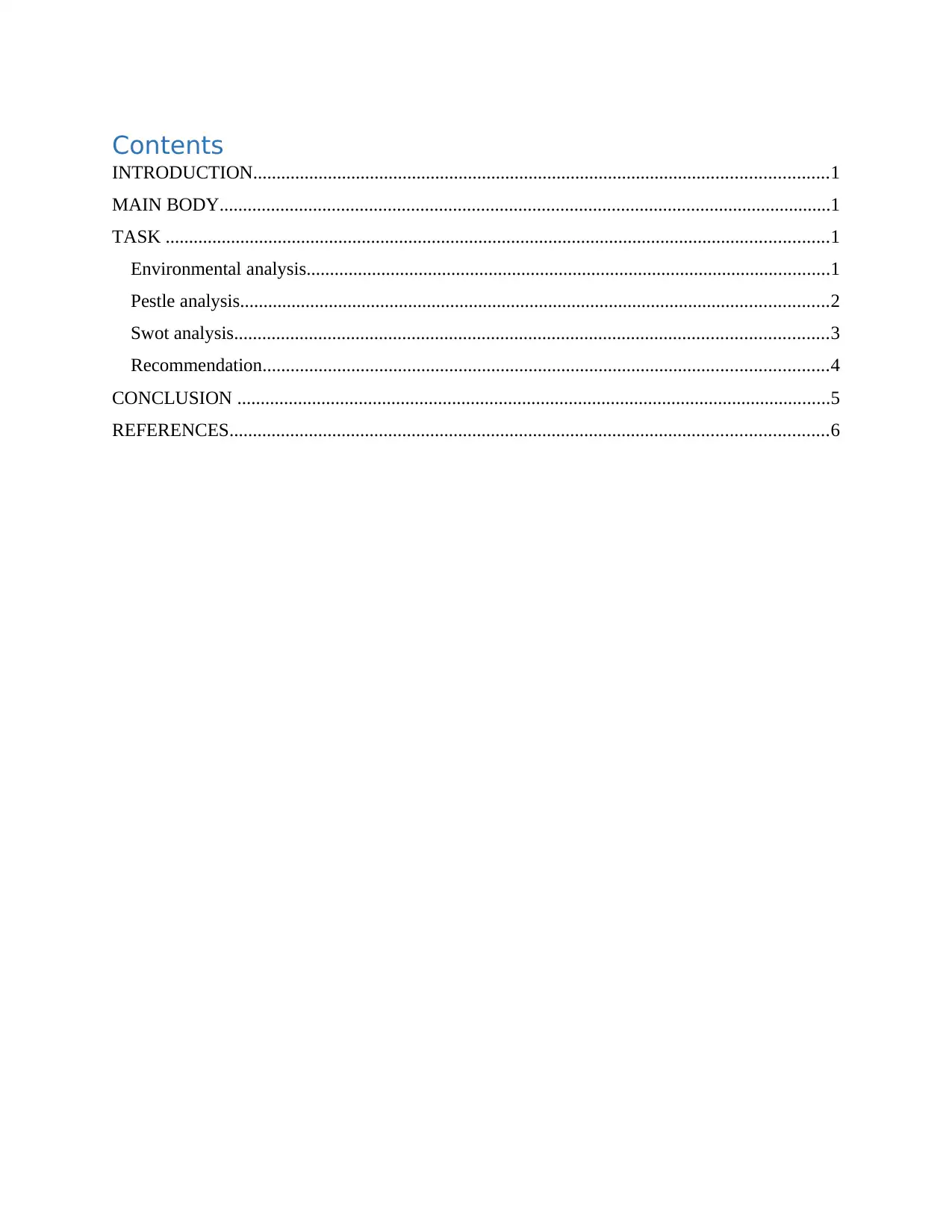
Contents
INTRODUCTION...........................................................................................................................1
MAIN BODY...................................................................................................................................1
TASK ..............................................................................................................................................1
Environmental analysis................................................................................................................1
Pestle analysis..............................................................................................................................2
Swot analysis...............................................................................................................................3
Recommendation.........................................................................................................................4
CONCLUSION ...............................................................................................................................5
REFERENCES................................................................................................................................6
INTRODUCTION...........................................................................................................................1
MAIN BODY...................................................................................................................................1
TASK ..............................................................................................................................................1
Environmental analysis................................................................................................................1
Pestle analysis..............................................................................................................................2
Swot analysis...............................................................................................................................3
Recommendation.........................................................................................................................4
CONCLUSION ...............................................................................................................................5
REFERENCES................................................................................................................................6

⊘ This is a preview!⊘
Do you want full access?
Subscribe today to unlock all pages.

Trusted by 1+ million students worldwide
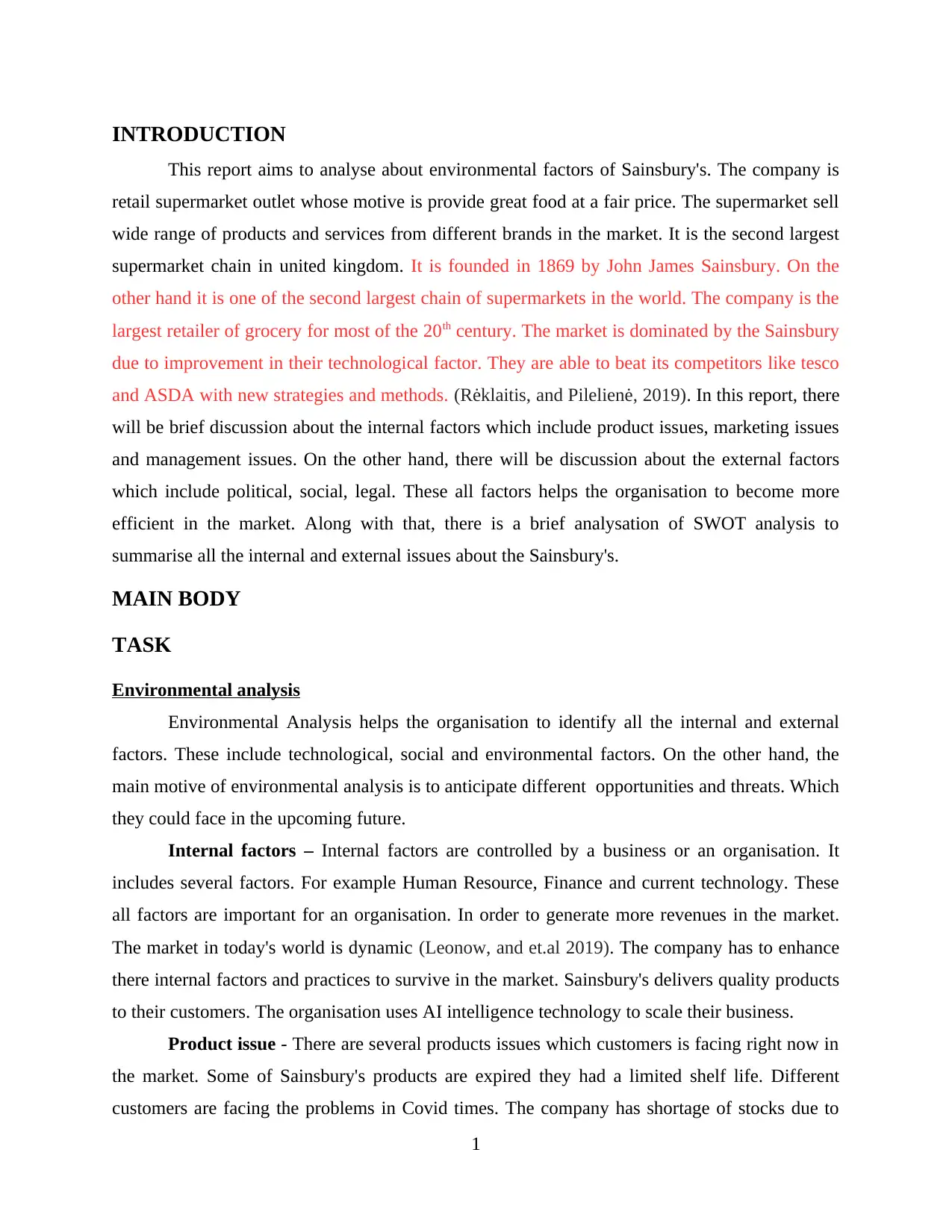
INTRODUCTION
This report aims to analyse about environmental factors of Sainsbury's. The company is
retail supermarket outlet whose motive is provide great food at a fair price. The supermarket sell
wide range of products and services from different brands in the market. It is the second largest
supermarket chain in united kingdom. It is founded in 1869 by John James Sainsbury. On the
other hand it is one of the second largest chain of supermarkets in the world. The company is the
largest retailer of grocery for most of the 20th century. The market is dominated by the Sainsbury
due to improvement in their technological factor. They are able to beat its competitors like tesco
and ASDA with new strategies and methods. (Rėklaitis, and Pilelienė, 2019). In this report, there
will be brief discussion about the internal factors which include product issues, marketing issues
and management issues. On the other hand, there will be discussion about the external factors
which include political, social, legal. These all factors helps the organisation to become more
efficient in the market. Along with that, there is a brief analysation of SWOT analysis to
summarise all the internal and external issues about the Sainsbury's.
MAIN BODY
TASK
Environmental analysis
Environmental Analysis helps the organisation to identify all the internal and external
factors. These include technological, social and environmental factors. On the other hand, the
main motive of environmental analysis is to anticipate different opportunities and threats. Which
they could face in the upcoming future.
Internal factors – Internal factors are controlled by a business or an organisation. It
includes several factors. For example Human Resource, Finance and current technology. These
all factors are important for an organisation. In order to generate more revenues in the market.
The market in today's world is dynamic (Leonow, and et.al 2019). The company has to enhance
there internal factors and practices to survive in the market. Sainsbury's delivers quality products
to their customers. The organisation uses AI intelligence technology to scale their business.
Product issue - There are several products issues which customers is facing right now in
the market. Some of Sainsbury's products are expired they had a limited shelf life. Different
customers are facing the problems in Covid times. The company has shortage of stocks due to
1
This report aims to analyse about environmental factors of Sainsbury's. The company is
retail supermarket outlet whose motive is provide great food at a fair price. The supermarket sell
wide range of products and services from different brands in the market. It is the second largest
supermarket chain in united kingdom. It is founded in 1869 by John James Sainsbury. On the
other hand it is one of the second largest chain of supermarkets in the world. The company is the
largest retailer of grocery for most of the 20th century. The market is dominated by the Sainsbury
due to improvement in their technological factor. They are able to beat its competitors like tesco
and ASDA with new strategies and methods. (Rėklaitis, and Pilelienė, 2019). In this report, there
will be brief discussion about the internal factors which include product issues, marketing issues
and management issues. On the other hand, there will be discussion about the external factors
which include political, social, legal. These all factors helps the organisation to become more
efficient in the market. Along with that, there is a brief analysation of SWOT analysis to
summarise all the internal and external issues about the Sainsbury's.
MAIN BODY
TASK
Environmental analysis
Environmental Analysis helps the organisation to identify all the internal and external
factors. These include technological, social and environmental factors. On the other hand, the
main motive of environmental analysis is to anticipate different opportunities and threats. Which
they could face in the upcoming future.
Internal factors – Internal factors are controlled by a business or an organisation. It
includes several factors. For example Human Resource, Finance and current technology. These
all factors are important for an organisation. In order to generate more revenues in the market.
The market in today's world is dynamic (Leonow, and et.al 2019). The company has to enhance
there internal factors and practices to survive in the market. Sainsbury's delivers quality products
to their customers. The organisation uses AI intelligence technology to scale their business.
Product issue - There are several products issues which customers is facing right now in
the market. Some of Sainsbury's products are expired they had a limited shelf life. Different
customers are facing the problems in Covid times. The company has shortage of stocks due to
1
Paraphrase This Document
Need a fresh take? Get an instant paraphrase of this document with our AI Paraphraser
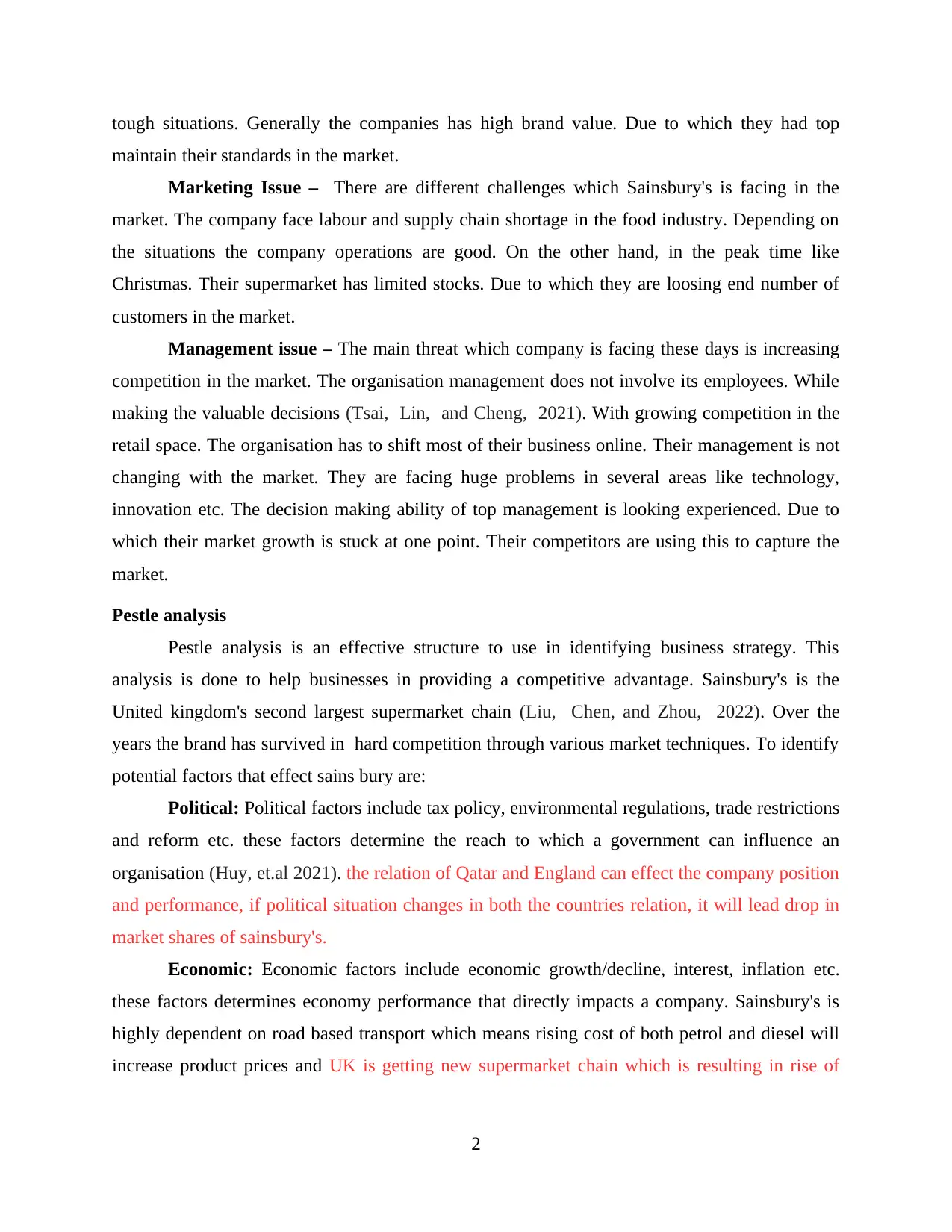
tough situations. Generally the companies has high brand value. Due to which they had top
maintain their standards in the market.
Marketing Issue – There are different challenges which Sainsbury's is facing in the
market. The company face labour and supply chain shortage in the food industry. Depending on
the situations the company operations are good. On the other hand, in the peak time like
Christmas. Their supermarket has limited stocks. Due to which they are loosing end number of
customers in the market.
Management issue – The main threat which company is facing these days is increasing
competition in the market. The organisation management does not involve its employees. While
making the valuable decisions (Tsai, Lin, and Cheng, 2021). With growing competition in the
retail space. The organisation has to shift most of their business online. Their management is not
changing with the market. They are facing huge problems in several areas like technology,
innovation etc. The decision making ability of top management is looking experienced. Due to
which their market growth is stuck at one point. Their competitors are using this to capture the
market.
Pestle analysis
Pestle analysis is an effective structure to use in identifying business strategy. This
analysis is done to help businesses in providing a competitive advantage. Sainsbury's is the
United kingdom's second largest supermarket chain (Liu, Chen, and Zhou, 2022). Over the
years the brand has survived in hard competition through various market techniques. To identify
potential factors that effect sains bury are:
Political: Political factors include tax policy, environmental regulations, trade restrictions
and reform etc. these factors determine the reach to which a government can influence an
organisation (Huy, et.al 2021). the relation of Qatar and England can effect the company position
and performance, if political situation changes in both the countries relation, it will lead drop in
market shares of sainsbury's.
Economic: Economic factors include economic growth/decline, interest, inflation etc.
these factors determines economy performance that directly impacts a company. Sainsbury's is
highly dependent on road based transport which means rising cost of both petrol and diesel will
increase product prices and UK is getting new supermarket chain which is resulting in rise of
2
maintain their standards in the market.
Marketing Issue – There are different challenges which Sainsbury's is facing in the
market. The company face labour and supply chain shortage in the food industry. Depending on
the situations the company operations are good. On the other hand, in the peak time like
Christmas. Their supermarket has limited stocks. Due to which they are loosing end number of
customers in the market.
Management issue – The main threat which company is facing these days is increasing
competition in the market. The organisation management does not involve its employees. While
making the valuable decisions (Tsai, Lin, and Cheng, 2021). With growing competition in the
retail space. The organisation has to shift most of their business online. Their management is not
changing with the market. They are facing huge problems in several areas like technology,
innovation etc. The decision making ability of top management is looking experienced. Due to
which their market growth is stuck at one point. Their competitors are using this to capture the
market.
Pestle analysis
Pestle analysis is an effective structure to use in identifying business strategy. This
analysis is done to help businesses in providing a competitive advantage. Sainsbury's is the
United kingdom's second largest supermarket chain (Liu, Chen, and Zhou, 2022). Over the
years the brand has survived in hard competition through various market techniques. To identify
potential factors that effect sains bury are:
Political: Political factors include tax policy, environmental regulations, trade restrictions
and reform etc. these factors determine the reach to which a government can influence an
organisation (Huy, et.al 2021). the relation of Qatar and England can effect the company position
and performance, if political situation changes in both the countries relation, it will lead drop in
market shares of sainsbury's.
Economic: Economic factors include economic growth/decline, interest, inflation etc.
these factors determines economy performance that directly impacts a company. Sainsbury's is
highly dependent on road based transport which means rising cost of both petrol and diesel will
increase product prices and UK is getting new supermarket chain which is resulting in rise of
2

competition for sainsbury's. The rivals are already present like Asda and Tesco with joinin new
ones Lidl and Aldi.
Social: These factors include cultural norms and expectations, population growth etc.
Sainsbury's need to change its fast food menu to healthy options as large part of its sale come
from fast food outlets (Xue, Wang, and 2022). However, the UK population is increasingly
shifting to heath conscious diet. The rise in price of grains, vegetables and other farm related
products is factor that is affecting consumer behaviour.
Technological: Technological factors mean the innovations and developments. These
factor impact an organization's operations. Sainsbury's uses e-commerce stores which is highly
helpful towards providing service to the new generation. The brand should start using features
such as modern data based analytical system and AI. This analytical method will help in
increasing the sales.
Legal: These factors include changes to import and exports, taxation laws, legislation etc.
certain laws have huge impact in businesses (Liu, and Liu, 2020). Sainsbury's faces loss in
market shares when regulation approval takes delay by government. With new introduction of
sugar taxation law the company needs to modify the products it make avail and save cost.
Environmental: This factor is concerned with surrounding environment and influence of
ecological feature. These include waste disposal laws, environmental protection laws, and energy
consumption rules (Wyszkowska-Kuna, 2020). Sainsbury's produces high level of carbon that
creates negative impact in environment, the brand need to look through this concern. The
company is starting to claim and acknowledging its customers to reduce the amount of food
waste in the surrounding.
Swot analysis
It is a study that is undertaken by the organisations to finds its internal strengths,
weaknesses and the external factors that is threats and opportunities. SWOT analysis helps in
evaluating the performance, risk and competition of a organisation. It helps an organisation to
make a successful plan for the future. This analysis helps in finding that areas of the business
which holds the business back than its competitors. It enhances the performance of the company.
SWOT analysis in relation to Sainsbury is as follows:
Strengths
Their main strengths is that they have
Weakness
There are many competitors present in
3
ones Lidl and Aldi.
Social: These factors include cultural norms and expectations, population growth etc.
Sainsbury's need to change its fast food menu to healthy options as large part of its sale come
from fast food outlets (Xue, Wang, and 2022). However, the UK population is increasingly
shifting to heath conscious diet. The rise in price of grains, vegetables and other farm related
products is factor that is affecting consumer behaviour.
Technological: Technological factors mean the innovations and developments. These
factor impact an organization's operations. Sainsbury's uses e-commerce stores which is highly
helpful towards providing service to the new generation. The brand should start using features
such as modern data based analytical system and AI. This analytical method will help in
increasing the sales.
Legal: These factors include changes to import and exports, taxation laws, legislation etc.
certain laws have huge impact in businesses (Liu, and Liu, 2020). Sainsbury's faces loss in
market shares when regulation approval takes delay by government. With new introduction of
sugar taxation law the company needs to modify the products it make avail and save cost.
Environmental: This factor is concerned with surrounding environment and influence of
ecological feature. These include waste disposal laws, environmental protection laws, and energy
consumption rules (Wyszkowska-Kuna, 2020). Sainsbury's produces high level of carbon that
creates negative impact in environment, the brand need to look through this concern. The
company is starting to claim and acknowledging its customers to reduce the amount of food
waste in the surrounding.
Swot analysis
It is a study that is undertaken by the organisations to finds its internal strengths,
weaknesses and the external factors that is threats and opportunities. SWOT analysis helps in
evaluating the performance, risk and competition of a organisation. It helps an organisation to
make a successful plan for the future. This analysis helps in finding that areas of the business
which holds the business back than its competitors. It enhances the performance of the company.
SWOT analysis in relation to Sainsbury is as follows:
Strengths
Their main strengths is that they have
Weakness
There are many competitors present in
3
⊘ This is a preview!⊘
Do you want full access?
Subscribe today to unlock all pages.

Trusted by 1+ million students worldwide
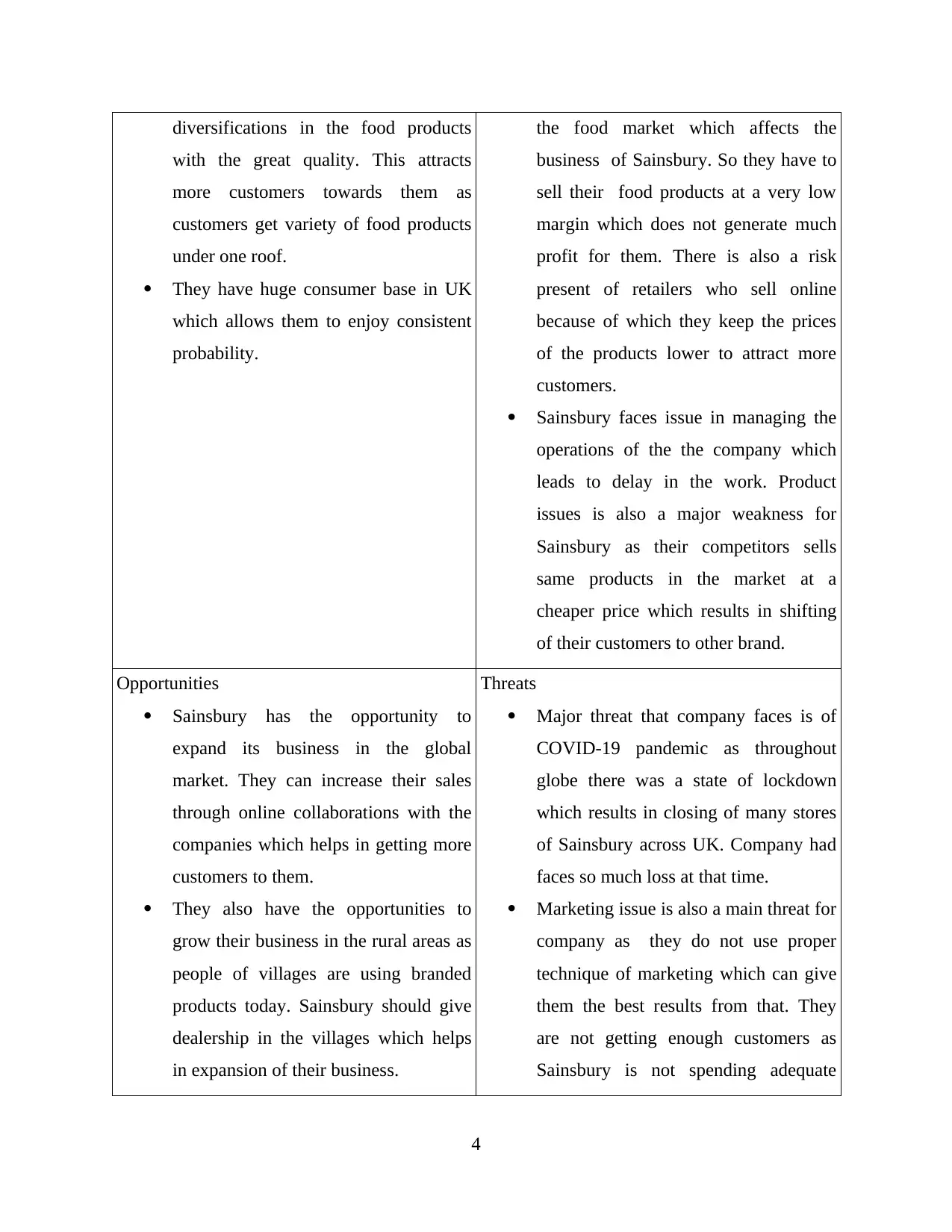
diversifications in the food products
with the great quality. This attracts
more customers towards them as
customers get variety of food products
under one roof.
They have huge consumer base in UK
which allows them to enjoy consistent
probability.
the food market which affects the
business of Sainsbury. So they have to
sell their food products at a very low
margin which does not generate much
profit for them. There is also a risk
present of retailers who sell online
because of which they keep the prices
of the products lower to attract more
customers.
Sainsbury faces issue in managing the
operations of the the company which
leads to delay in the work. Product
issues is also a major weakness for
Sainsbury as their competitors sells
same products in the market at a
cheaper price which results in shifting
of their customers to other brand.
Opportunities
Sainsbury has the opportunity to
expand its business in the global
market. They can increase their sales
through online collaborations with the
companies which helps in getting more
customers to them.
They also have the opportunities to
grow their business in the rural areas as
people of villages are using branded
products today. Sainsbury should give
dealership in the villages which helps
in expansion of their business.
Threats
Major threat that company faces is of
COVID-19 pandemic as throughout
globe there was a state of lockdown
which results in closing of many stores
of Sainsbury across UK. Company had
faces so much loss at that time.
Marketing issue is also a main threat for
company as they do not use proper
technique of marketing which can give
them the best results from that. They
are not getting enough customers as
Sainsbury is not spending adequate
4
with the great quality. This attracts
more customers towards them as
customers get variety of food products
under one roof.
They have huge consumer base in UK
which allows them to enjoy consistent
probability.
the food market which affects the
business of Sainsbury. So they have to
sell their food products at a very low
margin which does not generate much
profit for them. There is also a risk
present of retailers who sell online
because of which they keep the prices
of the products lower to attract more
customers.
Sainsbury faces issue in managing the
operations of the the company which
leads to delay in the work. Product
issues is also a major weakness for
Sainsbury as their competitors sells
same products in the market at a
cheaper price which results in shifting
of their customers to other brand.
Opportunities
Sainsbury has the opportunity to
expand its business in the global
market. They can increase their sales
through online collaborations with the
companies which helps in getting more
customers to them.
They also have the opportunities to
grow their business in the rural areas as
people of villages are using branded
products today. Sainsbury should give
dealership in the villages which helps
in expansion of their business.
Threats
Major threat that company faces is of
COVID-19 pandemic as throughout
globe there was a state of lockdown
which results in closing of many stores
of Sainsbury across UK. Company had
faces so much loss at that time.
Marketing issue is also a main threat for
company as they do not use proper
technique of marketing which can give
them the best results from that. They
are not getting enough customers as
Sainsbury is not spending adequate
4
Paraphrase This Document
Need a fresh take? Get an instant paraphrase of this document with our AI Paraphraser
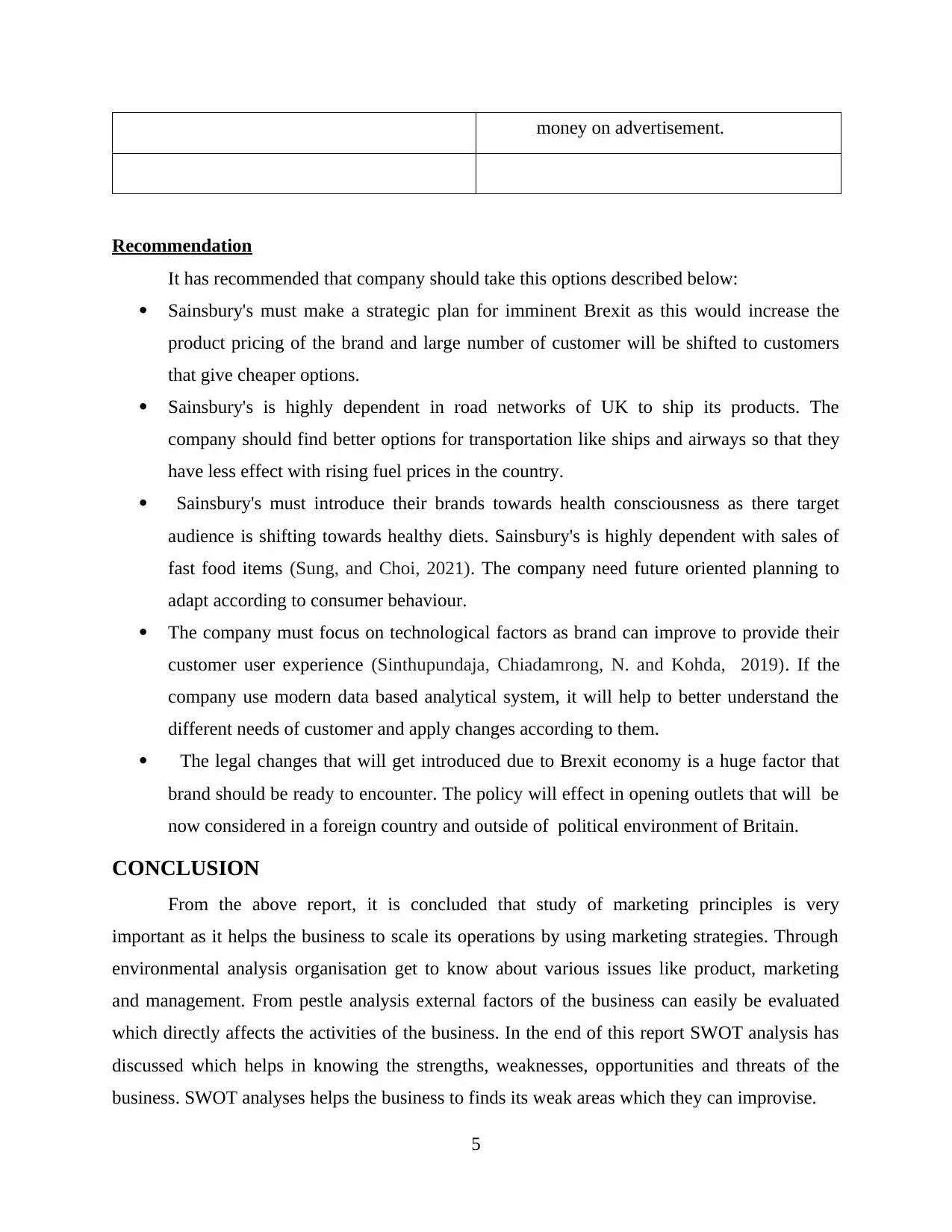
money on advertisement.
Recommendation
It has recommended that company should take this options described below:
Sainsbury's must make a strategic plan for imminent Brexit as this would increase the
product pricing of the brand and large number of customer will be shifted to customers
that give cheaper options.
Sainsbury's is highly dependent in road networks of UK to ship its products. The
company should find better options for transportation like ships and airways so that they
have less effect with rising fuel prices in the country.
Sainsbury's must introduce their brands towards health consciousness as there target
audience is shifting towards healthy diets. Sainsbury's is highly dependent with sales of
fast food items (Sung, and Choi, 2021). The company need future oriented planning to
adapt according to consumer behaviour.
The company must focus on technological factors as brand can improve to provide their
customer user experience (Sinthupundaja, Chiadamrong, N. and Kohda, 2019). If the
company use modern data based analytical system, it will help to better understand the
different needs of customer and apply changes according to them.
The legal changes that will get introduced due to Brexit economy is a huge factor that
brand should be ready to encounter. The policy will effect in opening outlets that will be
now considered in a foreign country and outside of political environment of Britain.
CONCLUSION
From the above report, it is concluded that study of marketing principles is very
important as it helps the business to scale its operations by using marketing strategies. Through
environmental analysis organisation get to know about various issues like product, marketing
and management. From pestle analysis external factors of the business can easily be evaluated
which directly affects the activities of the business. In the end of this report SWOT analysis has
discussed which helps in knowing the strengths, weaknesses, opportunities and threats of the
business. SWOT analyses helps the business to finds its weak areas which they can improvise.
5
Recommendation
It has recommended that company should take this options described below:
Sainsbury's must make a strategic plan for imminent Brexit as this would increase the
product pricing of the brand and large number of customer will be shifted to customers
that give cheaper options.
Sainsbury's is highly dependent in road networks of UK to ship its products. The
company should find better options for transportation like ships and airways so that they
have less effect with rising fuel prices in the country.
Sainsbury's must introduce their brands towards health consciousness as there target
audience is shifting towards healthy diets. Sainsbury's is highly dependent with sales of
fast food items (Sung, and Choi, 2021). The company need future oriented planning to
adapt according to consumer behaviour.
The company must focus on technological factors as brand can improve to provide their
customer user experience (Sinthupundaja, Chiadamrong, N. and Kohda, 2019). If the
company use modern data based analytical system, it will help to better understand the
different needs of customer and apply changes according to them.
The legal changes that will get introduced due to Brexit economy is a huge factor that
brand should be ready to encounter. The policy will effect in opening outlets that will be
now considered in a foreign country and outside of political environment of Britain.
CONCLUSION
From the above report, it is concluded that study of marketing principles is very
important as it helps the business to scale its operations by using marketing strategies. Through
environmental analysis organisation get to know about various issues like product, marketing
and management. From pestle analysis external factors of the business can easily be evaluated
which directly affects the activities of the business. In the end of this report SWOT analysis has
discussed which helps in knowing the strengths, weaknesses, opportunities and threats of the
business. SWOT analyses helps the business to finds its weak areas which they can improvise.
5

REFERENCES
Books and Journals:
Rėklaitis, K. and Pilelienė, L., 2019. Principle differences between B2B and B2C marketing
communication processes. Organizacijų vadyba: sisteminiai tyrimai= Management of
organizations: systematic research. Kaunas: Vytauto Didžiojo universitetas; Sciendo,
2019, T. 81.
Leonow, and et.al 2019. Application of information technologies in marketing: experience of
developing countries. Revista Espacios, 40(38).
Tsai, Lin, and Cheng, 2021. A comprehensive quality improvement model: integrating internal
and external information. Total Quality Management & Business Excellence, pp.1-18.
Liu, Chen, and Zhou, 2022. Internal and External Factors Analysis of Kenya Airways’ Strategic
Management: A Mini-Review. Frontiers in Business, Economics and Management, 3(1),
pp.13-17.
Huy, et.al 2021. Impacts of Internal and External Macroeconomic Factors on Firm Stock Price in
an Expansion Econometric model—A Case in Vietnam Real Estate Industry. In Data
Science for Financial Econometrics (pp. 189-205). Springer, Cham.
Xue, Wang, and 2022. Market Integration and Price Dynamics under Market Shocks in
European Union Internal and External Cheese Export Markets. Foods, 11(5), p.692.
Liu, and Liu, 2020. Impact of human capital strategies on employee attitudes and behavior: a
view of internal and external labor markets. International Journal of Manpower.
6
Books and Journals:
Rėklaitis, K. and Pilelienė, L., 2019. Principle differences between B2B and B2C marketing
communication processes. Organizacijų vadyba: sisteminiai tyrimai= Management of
organizations: systematic research. Kaunas: Vytauto Didžiojo universitetas; Sciendo,
2019, T. 81.
Leonow, and et.al 2019. Application of information technologies in marketing: experience of
developing countries. Revista Espacios, 40(38).
Tsai, Lin, and Cheng, 2021. A comprehensive quality improvement model: integrating internal
and external information. Total Quality Management & Business Excellence, pp.1-18.
Liu, Chen, and Zhou, 2022. Internal and External Factors Analysis of Kenya Airways’ Strategic
Management: A Mini-Review. Frontiers in Business, Economics and Management, 3(1),
pp.13-17.
Huy, et.al 2021. Impacts of Internal and External Macroeconomic Factors on Firm Stock Price in
an Expansion Econometric model—A Case in Vietnam Real Estate Industry. In Data
Science for Financial Econometrics (pp. 189-205). Springer, Cham.
Xue, Wang, and 2022. Market Integration and Price Dynamics under Market Shocks in
European Union Internal and External Cheese Export Markets. Foods, 11(5), p.692.
Liu, and Liu, 2020. Impact of human capital strategies on employee attitudes and behavior: a
view of internal and external labor markets. International Journal of Manpower.
6
⊘ This is a preview!⊘
Do you want full access?
Subscribe today to unlock all pages.

Trusted by 1+ million students worldwide
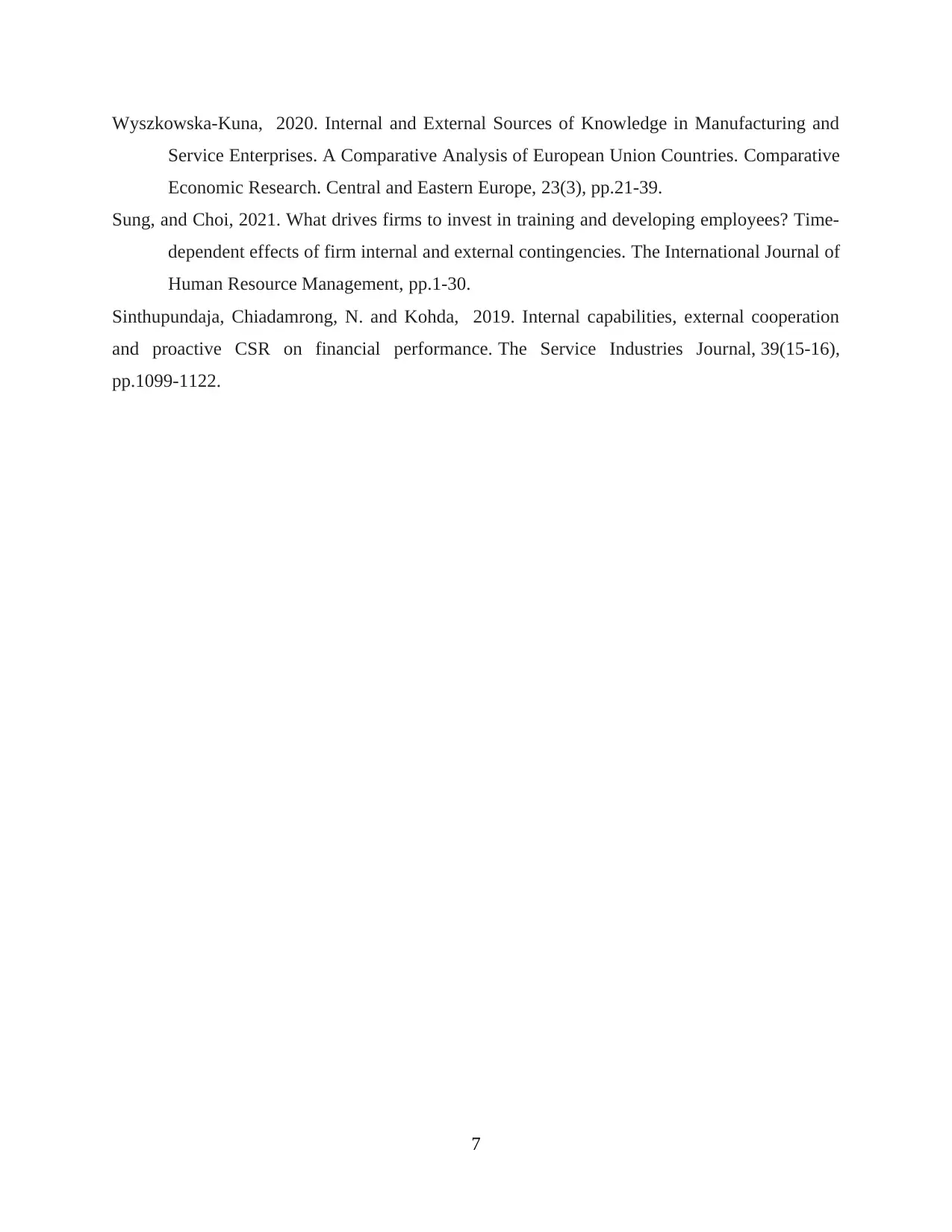
Wyszkowska-Kuna, 2020. Internal and External Sources of Knowledge in Manufacturing and
Service Enterprises. A Comparative Analysis of European Union Countries. Comparative
Economic Research. Central and Eastern Europe, 23(3), pp.21-39.
Sung, and Choi, 2021. What drives firms to invest in training and developing employees? Time-
dependent effects of firm internal and external contingencies. The International Journal of
Human Resource Management, pp.1-30.
Sinthupundaja, Chiadamrong, N. and Kohda, 2019. Internal capabilities, external cooperation
and proactive CSR on financial performance. The Service Industries Journal, 39(15-16),
pp.1099-1122.
7
Service Enterprises. A Comparative Analysis of European Union Countries. Comparative
Economic Research. Central and Eastern Europe, 23(3), pp.21-39.
Sung, and Choi, 2021. What drives firms to invest in training and developing employees? Time-
dependent effects of firm internal and external contingencies. The International Journal of
Human Resource Management, pp.1-30.
Sinthupundaja, Chiadamrong, N. and Kohda, 2019. Internal capabilities, external cooperation
and proactive CSR on financial performance. The Service Industries Journal, 39(15-16),
pp.1099-1122.
7
1 out of 10
Related Documents
Your All-in-One AI-Powered Toolkit for Academic Success.
+13062052269
info@desklib.com
Available 24*7 on WhatsApp / Email
![[object Object]](/_next/static/media/star-bottom.7253800d.svg)
Unlock your academic potential
Copyright © 2020–2025 A2Z Services. All Rights Reserved. Developed and managed by ZUCOL.





